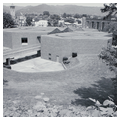The source of Moundsville's name has a base circumference of 295 feet and is 69 feet tall. The
Beginning in the eighteenth century, many pioneers and travelers visited the mound and recorded their impressions. Some of their comments, along with a more complete discussion of the mound and its significance, are part of the general introduction to this volume.
At the beginning of the twentieth century, interest in the state's acquisition and preservation of the mound began to gain momentum. In 1915 the nearby West Virginia State Penitentiary assumed responsibility for protection and maintenance, and a small stone museum (still standing but now vacant) was erected near the base. In 1966 the Grave Creek Mound was declared a National Historic Landmark, and in 1967 it was transferred to the State Department of Natural Resources. It is now the centerpiece of a park operated by the West Virginia Division of Culture and History. The site finally acquired a museum worthy of the name in the late 1970s. The Delf Norona Museum, named for a longtime student of the mound who wrote its definitive history, is a sensitively scaled, minimalist brick and glass structure. Subtle architectural hints relate to the mound, but the museum is a respectful understudy that appropriately lets the mound take center stage. The entrance is at ground level, and an interior ramp, suggestive of the ramp circling the mound, leads upward. Displays alongside the ramp portray succeeding levels of civilization, the Adena culture, and the mound's history. Access to the mound is from the upper level, where a large window focuses dramatically on it. The Cincinnati architect received input from interested Moundsville citizens during the design process. In 2002, parts of the museum were reconfigured to house the West Virginia Archeological Collection.




